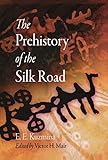The Prehistory of the Silk Road / E. E. Kuzmina; ed. by Victor H. Mair.
Material type: TextSeries: Encounters with AsiaPublisher: Philadelphia : University of Pennsylvania Press, [2015]Copyright date: ©2008Description: 1 online resource (264 p.) : 73 illusContent type:
TextSeries: Encounters with AsiaPublisher: Philadelphia : University of Pennsylvania Press, [2015]Copyright date: ©2008Description: 1 online resource (264 p.) : 73 illusContent type: - 9780812240412
- 9780812292336
- 939/.6 22
- DS328 .K89 2008eb
- online - DeGruyter
- Issued also in print.
| Item type | Current library | Call number | URL | Status | Notes | Barcode | |
|---|---|---|---|---|---|---|---|
 eBook
eBook
|
Biblioteca "Angelicum" Pont. Univ. S.Tommaso d'Aquino Nuvola online | online - DeGruyter (Browse shelf(Opens below)) | Online access | Not for loan (Accesso limitato) | Accesso per gli utenti autorizzati / Access for authorized users | (dgr)9780812292336 |
Frontmatter -- Contents -- Editor's Foreword -- A Note on Transcription -- Introduction -- Chapter 1.The Dynamics of the Eurasian Steppe Ecology -- Chapter 2. Economic Developments in the Ponto-Caspian Steppe -- Chapter 3. The Eurasian Steppe In the Bronze Age -- Chapter 4. Archaeological Cultures of Southern Central Asia -- Chapter 5. Relations Between Eastern and Western Central Asia -- Chapter 6. Conclusion -- Appendix. Dating and Comparative Chronologies -- Maps and Illustrations -- Notes -- Bibliography -- Index
restricted access online access with authorization star
http://purl.org/coar/access_right/c_16ec
In ancient and medieval times, the Silk Road was of great importance to the transport of peoples, goods, and ideas between the East and the West. A vast network of trade routes, it connected the diverse geographies and populations of China, the Eurasian Steppe, Central Asia, India, Western Asia, and Europe. Although its main use was for importing silk from China, traders moving in the opposite direction carried to China jewelry, glassware, and other exotic goods from the Mediterranean, jade from Khotan, and horses and furs from the nomads of the Steppe. In both directions, technology and ideologies were transmitted. The Silk Road brought together the achievements of the different peoples of Eurasia to advance the Old World as a whole.The majority of the Silk Road routes passed through the Eurasian Steppe, whose nomadic people were participants and mediators in its economic and cultural exchanges. Until now, the origins of these routes and relationships have not been examined in great detail. In The Prehistory of the Silk Road, E. E. Kuzmina, renowned Russian archaeologist, looks at the history of this crucial area before the formal establishment of Silk Road trade and diplomacy. From the late Neolithic period to the early Bronze Age, Kuzmina traces the evolution of the material culture of the Steppe and the contact between civilizations that proved critical to the development of the widespread trade that would follow, including nomadic migrations, the domestication and use of the horse and the camel, and the spread of wheeled transport.The Prehistory of the Silk Road combines detailed research in archaeology with evidence from physical anthropology, linguistics, and other fields, incorporating both primary and secondary sources from a range of languages, including a vast accumulation of Russian-language scholarship largely untapped in the West. The book is complemented by an extensive bibliography that will be of great use to scholars.
Issued also in print.
Mode of access: Internet via World Wide Web.
In English.
Description based on online resource; title from PDF title page (publisher's Web site, viewed 24. Apr 2022)


